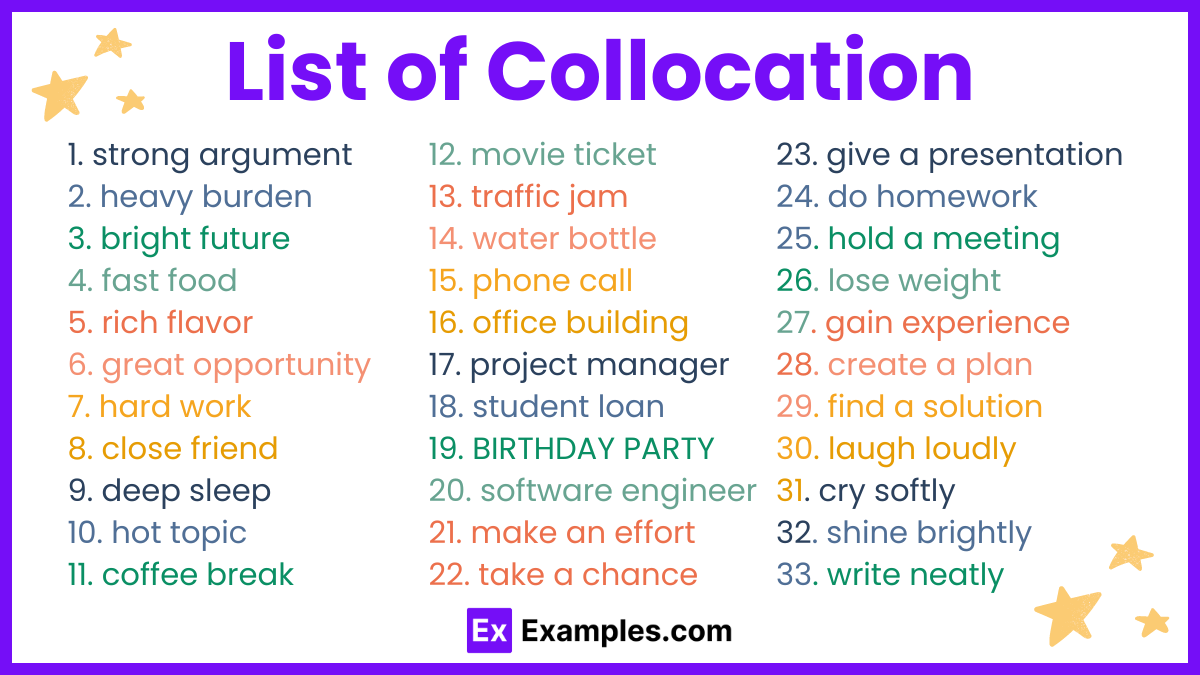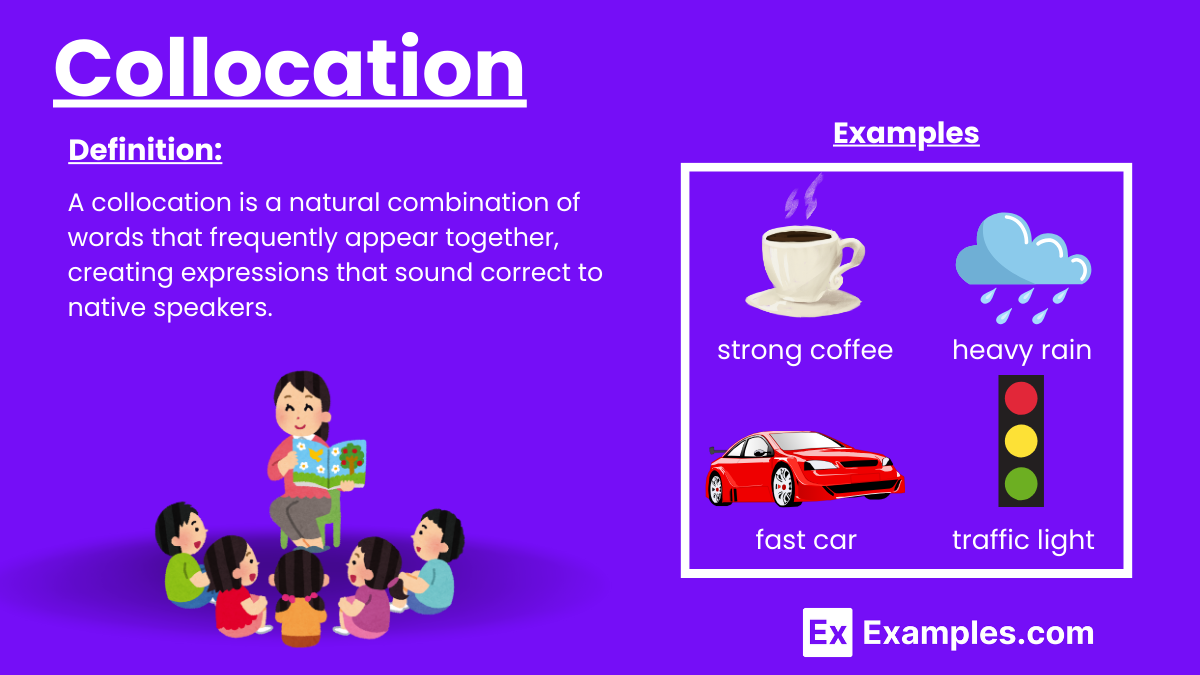70+ Collocation Examples
Collocation refers to the habitual combination of words that frequently occur together in a language, sounding natural to native speakers and conveying specific meanings or nuances. For example, English speakers say “make a decision” instead of “do a decision” and “strong tea” rather than “powerful tea.” Understanding collocations helps learners produce more natural-sounding sentences and grasp subtle meanings. Juxtaposition places elements close together for contrast or effect, an Adjective Prepositional Phrase describes a noun or pronoun (e.g., “on the table”), and a Noun identifies a person, place, thing, or idea.
What is Collocation?
Collocation refers to the habitual combination of words in a language, where certain words tend to occur together more frequently than would be expected by chance. These word combinations are often predictable and sound natural to native speakers.
Examples of Collocation
- strong coffee
- heavy rain
- bright idea
- fast car
- rich history
- traffic light
- bus stop
- family member
- chicken soup
- business meeting
- make a decision
- take a break
- save money
- catch a bus
- write an essay
- run quickly
- speak clearly
- drive slowly
- listen carefully
- work hard
- deeply sorry
- highly successful
- extremely important
- completely different
- absolutely necessary
- dogs bark
- birds sing
- wind blows
- snow falls
- leaves change
List of Collocation

- strong argument
- heavy burden
- bright future
- fast food
- rich flavor
- great opportunity
- hard work
- close friend
- deep sleep
- hot topic
- coffee break
- movie ticket
- traffic jam
- water bottle
- phone call
- office building
- project manager
- student loan
- birthday party
- software engineer
- make an effort
- take a chance
- give a presentation
- do homework
- have a conversation
- hold a meeting
- lose weight
- gain experience
- create a plan
- find a solution
- laugh loudly
- cry softly
- shine brightly
- work efficiently
- rest peacefully
- drive carefully
- speak quietly
- write neatly
- run swiftly
- move slowly
- highly recommended
- deeply concerned
- perfectly balanced
- completely satisfied
- totally unexpected
- fully aware
- hardly noticeable
- nearly impossible
- barely visible
- utterly ridiculous
How to Learn Collocations?
1. Read Extensively
Reading books, articles, and other texts in English exposes you to natural language use. Pay attention to how words are commonly paired together.
2. Use Collocation Dictionaries
Specialized dictionaries list common collocations. Examples include the Oxford Collocations Dictionary and Macmillan Collocations Dictionary.
3. Practice Regularly
Incorporate collocations into your daily speech and writing. Practice forming sentences using new collocations you learn.
4. Listen to Native Speakers
Listen to English podcasts, watch movies, and engage in conversations with native speakers. Note the collocations they use.
5. Write and Review
Write sentences or short paragraphs using new collocations. Review and revise your writing to ensure correct usage.
6. Use Flashcards
Create flashcards with collocations on them. On one side, write the collocation (e.g., make a decision), and on the other side, use it in a sentence.
7. Engage in Interactive Exercises
Use language learning apps and websites that offer exercises on collocations. These platforms often provide immediate feedback.
8. Group Study
Study with friends or classmates. Practicing collocations together can be more engaging and beneficial.
9. Collocation Lists
Keep a list of collocations that you come across. Group them by categories like Adjective + Noun, Verb + Noun, etc.
10. Use Mnemonics
Create memory aids for collocations. For instance, associate “make a decision” with a mental image of someone making a choice.
Importance of Collocation
Enhances Fluency and Naturalness
- Native-like Speech: Using collocations makes your speech sound more natural and fluent.
- Smooth Communication: Helps you express ideas more clearly and effectively.
Improves Comprehension
- Better Understanding: Recognizing common word pairings improves listening and reading comprehension.
- Context Clues: Collocations provide context that aids in understanding the meaning of new words.
Boosts Vocabulary
- Word Combinations: Learning collocations expands your vocabulary by teaching you word pairs and phrases.
- Contextual Learning: You learn how words are used in context, which enhances retention.
Aids in Writing
- Effective Writing: Using collocations correctly makes your writing more professional and polished.
- Variety: It helps you avoid repetition and use a variety of expressions.
Enhances Language Learning
- Quick Learning: Collocations help you learn and remember words faster because they are often used together.
- Practical Use: Focuses on practical language use rather than isolated vocabulary.
Collocation in Semantics
Collocation in semantics refers to the way certain words naturally pair together to convey specific meanings. These word pairings are contextually appropriate and often carry connotations or nuances that single words alone cannot express. Understanding collocations helps in grasping the semantic relationships between words, leading to more fluent and natural language use.
Examples of Semantic Collocations
- Strong coffee
- This implies coffee with a potent flavor or high caffeine content.
- Example: “I need a cup of strong coffee to wake up.”
- Heavy rain
- This describes a large amount of rainfall.
- Example: “The heavy rain caused flooding in the streets.”
- Bright future
- This suggests a promising and successful future.
- Example: “She has a bright future ahead of her in medicine.”
- Fast food
- This refers to food that is prepared and served quickly.
- Example: “They often eat fast food for lunch.”
- Rich flavor
- This indicates a complex and intense taste.
- Example: “The soup had a rich flavor thanks to the fresh herbs.”
Tips for Learning Collocation
1. Read Extensively
- Read a variety of materials: Books, newspapers, magazines, and online articles.
- Highlight collocations: As you read, mark phrases that commonly appear together.
2. Use Collocation Dictionaries
- Invest in a good collocation dictionary: These are specifically designed to show which words go together.
- Online resources: Websites like the Oxford Collocations Dictionary offer extensive collocation lists.
3. Practice with Flashcards
- Create flashcards: Write down collocations on flashcards. One side should have the base word, and the other side should have its collocations.
- Use apps: Digital flashcard apps like Anki or Quizlet can be useful for repetitive learning.
4. Write Regularly
- Incorporate collocations: When writing essays, emails, or journal entries, consciously use the collocations you’ve learned.
- Review and revise: Go back to your writings and identify incorrect collocations, then correct them.
5. Listen and Repeat
- Watch English media: Movies, TV shows, and podcasts are excellent sources of natural language.
- Repeat phrases: Pause and repeat sentences, focusing on the collocations used.
6. Engage in Conversations
- Practice speaking: Use new collocations in conversations with friends, language partners, or tutors.
- Join language clubs: Participate in English speaking clubs or online forums to practice regularly.
7. Learn by Topic
- Categorize collocations: Group them by topics such as business, travel, or everyday activities.
- Focus on relevant collocations: Learn the collocations most useful for your specific needs or interests.
8. Use Language Apps
- Download language learning apps: Apps like Memrise and Duolingo often include collocation practice.
- Daily practice: Set aside time each day to practice using these apps.
9. Mind Maps
- Create mind maps: Visualize collocations by creating mind maps with a base word in the center and related collocations branching out.
- Review regularly: Keep your mind maps accessible for frequent review.
10. Teacher or Tutor Guidance
- Seek feedback: Have a teacher or tutor review your use of collocations and provide feedback.
- Structured lessons: Follow a structured lesson plan focused on collocation learning.
FAQs
Why are collocations important?
Collocations make language sound natural and fluent. Using correct collocations improves your speaking and writing skills, making communication more effective.
Can you give examples of common collocations?
Examples include “make a decision,” “take a risk,” “heavy rain,” and “strong coffee.” These word pairs are frequently used together.
How can I learn collocations effectively?
Practice by reading extensively, using collocation dictionaries, and paying attention to how words are paired in authentic texts. Practice using them in sentences.
Are collocations the same in all languages?
No, collocations vary across languages. What sounds natural in one language may not in another. Each language has its unique collocational patterns.
What are some common collocation types?
Common types include verb-noun (make a mistake), adjective-noun (strong tea), and verb-adverb (run quickly). These patterns help create natural-sounding phrases.
What is the difference between collocations and idioms?
Collocations are word pairs that often go together, while idioms are phrases with meanings different from the literal meanings of their words, like “kick the bucket.”
Can collocations change over time?
Yes, collocations can evolve with language use. New expressions can become common as language and culture change.
How do collocations help in language tests?
Using correct collocations in writing and speaking tests demonstrates language proficiency and fluency, improving your overall score.
What are strong and weak collocations?
Strong collocations are pairs of words that almost always appear together, like “make a decision.” Weak collocations are less predictable and more flexible.
Can you use collocations incorrectly?
Yes, incorrect use of collocations can make language sound awkward or confusing. Learning and practicing common collocations helps avoid mistakes.
How do dictionaries help with collocations?
Many dictionaries, especially collocation dictionaries, provide examples of how words are commonly paired, helping learners use them correctly.



